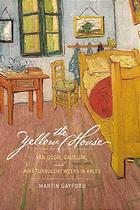
The Yellow House
Van Gogh, Gauguin, and Nine Turbulent Weeks in Arles
فرمت کتاب
ebook
تاریخ انتشار
2009
Reading Level
7
ATOS
8.7
Interest Level
9-12(UG)
نویسنده
Martin Gayfordشابک
9780316087209
کتاب های مرتبط
- اطلاعات
- نقد و بررسی
- دیدگاه کاربران
نقد و بررسی

Starred review from September 18, 2006
Van Gogh's reputation in the public imagination has been made as much by his descent into madness as by his art. Detailing the final year of his life and the "Studio of the South" in which Gauguin and Van Gogh painted side by side, Gayford brings the art back into focus. Explications of the works illuminate the collaboration—similar subjects find very different treatment by two entirely different temperaments. Yet their influence on each other is everywhere—a story that Van Gogh recommends to Gauguin finds its way into a painting; Van Gogh uses the jute canvas that is Gauguin's material of choice. While some of this is well-trodden territory, Gayford's narrative is genuinely dramatic as it moves toward Van Gogh's fateful end. Gayford makes exciting new connections between the tone of Van Gogh's correspondence and known scholarship about his probable bipolar disorder. The influences of literature, the news media and so-called "hygienic excursions" (visits to the local brothels) percolate in these letters and under the surfaces of the artists' canvases. So, argues Gayford, were they invading Van Gogh's mind. Though it is impossible to entirely understand what motivated these two great artists during their weeks together in Arles, these pages deliver as close and vivid an image as may be possible. 60 b&w illus.

November 1, 2006
Adult/High School-In an accessible and even affectionate work of art history, Gayford tells of the two artists who lived and worked in the South of France in the fall of 1888. Their story is told in short episodes, reconstructed through the formal analysis and comparison of the paintings they created during this period, and through letters and newspapers that place the work in the context of the contemporary art world, popular literature, and current events. Their time together culminated in Van Gogh's famous ear-cutting incident (which is revealed on the jacket copy), teens with an interest in the artist's colorful yet short life may take to Gayford's somewhat breathless approach leading up to the big event. The author delights in the quotidian details of his story: the joint visits to local brothels, how the weather may have affected work habits, Gauguin's cooking skills. The biggest drawback is the use of small black-and-white photos of paintings. Suggest that teens read this alongside larger monographs with color reproductions to appreciate the art fully."Jenny Gasset, Orange County Public Library, CA"
Copyright 2006 School Library Journal, LLC Used with permission.

January 1, 2007
Art critic Gayford offers a stimulating study of art history's truly odd couple, the calm Paul Gauguin and the explosive Vincent van Gogh. Adding to this work's historical value is the period covered1888which precedes their acknowledged fame. Gayford offers insights into the concerns of these future giants and outlines their everyday activities, including what they cooked and ate, their walks, their brothel visits, and their discussions. He explores in detail the bipolar affliction he believes was responsible for van Gogh's moments of insanity, covering exclusively the nine weeks before van Gogh's infamous act of self-mutilation and its immediate aftermath. But Gayford also provides a masterful sketch of Gauguin's and van Gogh's differing temperaments and aesthetical approaches to the objects they painted. He succeeds in reinforcing their mutual understanding and influence on each other, keeping the focus on their paintings. This blend of art history, biography, and criticism is as engaging and captivating as it is informative. Recommended for all public and academic libraries.Edward K. Owusu-Ansah, Kingsborough Community Coll. Lib., CUNY
Copyright 2007 Library Journal, LLC Used with permission.

November 1, 2006
In this intelligent and engrossing book, Gayford offers an unusually vivid retelling of the famous events of late 1888, when Vincent van Gogh and Paul Gauguin shared a studio in a small town in southern France. Relying heavily on their voluminous correspondence (written mostly to Theo van Gogh, Vincent's brother and Gauguin's art dealer), Gayford follows their trajectory from harmony to discord and, finally, van Gogh's madness. The book reveals the complicated dynamics of the relationship: desperately lonely, van Gogh wanted Gauguin to remain in Arles as long as possible, yet his increasingly vehement arguing repelled his friend. And better than most others who have attempted it, Gayford illuminates how the two artists influenced each other's work. Van Gogh, for instance, might never have completed one of his masterpieces, his final version of " The Sower," without the lessons provided by Gauguin's diagonal compositions and foregrounded figures. Gayford persuasively diagnoses van Gogh's illness (bipolar disorder) and even provides a plausible rationale for the notorious incident of the artist's lopping off of his own ear.(Reprinted with permission of Booklist, copyright 2006, American Library Association.)

























دیدگاه کاربران